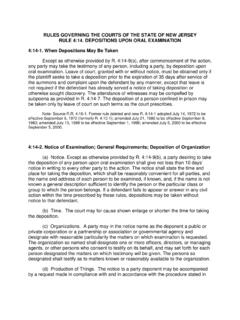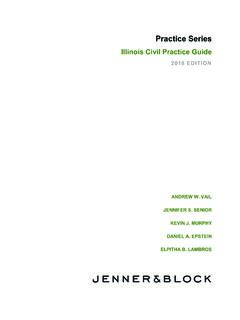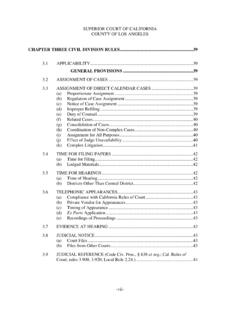Transcription of Florida Conference of Circuit Judges
1 Florida Conference of Circuit Judges Hon. Angela J. Cowden, Chair Conference of County Court Judges of Florida Hon. David L. Denkin, President Trial Lawyers Section of The Florida Bar Mindy McLaughlin, Chair TLS Discovery Handbook Committee Nick Mizell, Editor and Chair Hon. Elizabeth Rice Hon. Ralph Artigliere John Williams Prof. William Hamilton Rachael Loukonen Weston F. Smith Kim Ashby Joseph Skooter Kinman PREFACE. In 1994, the Trial Lawyers Section of The Florida Bar, the Conference of Circuit Judges , and the Conference of County Court Judges formed a joint committee to provide a forum for the exchange of ideas on how to improve the day-to-day practice of law for trial lawyers and trial Judges . At the committee's first meeting, it was the overwhelming consensus that discovery abuse should be the top priority.
2 The original handbook and the later editions are the result of the continued joint efforts of the Trial Lawyers Section, the Conference of Circuit Judges , and the Conference of County Court Judges . It is intended to be a quick reference for lawyers and Judges on many recurring discovery problems. It does not profess to be the dispositive legal authority on any particular issue. It is designed to help busy lawyers and Judges quickly access legal authority for the covered topics. The ultimate objective is to help curtail perceived abuses in discovery so that the search for truth is not thwarted by the discovery process itself. The reader should still do his or her own research, to include a review of local administrative orders and rules. The first edition of this handbook was prepared in the fall of 1995.
3 This 2019. (seventeenth) edition updates the handbook through December 2018. TABLE OF CONTENTS. Chapter 1: Discovery Standard and Expectations .. 1. Chapter 2: Preservation and Spoliation of Evidence .. 3. Preservation .. 3. Safe Harbor for Electronically Stored Information .. 5. 6. 7. Chapter 3: Electronic Discovery .. 10. The Duty of Electronic Discovery Competence .. 10. Law, Policy, and Principles of Electronic Discovery .. 11. Protecting Client Confidences and Data .. 19. Duties of Attorney and Client Regarding Preservation of ESI .. 20. Florida 's Safe Harbor Provision .. 27. Conferring with Opposing Counsel .. 27. Key Word Search, Relevancy and Scope of Discovery .. 29. Collection and Review of ESI .. 31. Framework for the Trial Lawyer Facing E-Discovery.
4 33. Requesting Production and Making Production of ESI .. 38. Production of ESI Pursuant to Subpoena .. 41. Discovery of Social Media ESI .. 42. Discovery of Electronic Media and Health Records .. 43. Inspection of Opposing Party Devices .. 45. Self-Help Discovery .. 48. Ten Practical Steps for Handling Electronic Evidence .. 51. Conclusion .. 54. Chapter 4: Written Discovery Practice .. 55. Documents Requested .. 55. Duty of Good Faith and Due Diligence .. 55. Formulating Requests for Documents .. 55. Use of Form 55. Reading and Interpreting Requests for 56. Contact When a document Request is Received .. 56. Responding to document Requests .. 57. Objections .. 58. When Production is Limited by Interpretation .. 59. Supplementation of document Production .. 60.
5 Claim of Privilege .. 60. Oral Requests for Production of Documents .. 61. Location of Production .. 61. Available for Copying .. 61. Manner of Production .. 62. Listing and Marking .. 62. Copying .. 63. Scanning .. 64. Later Inspection .. 64. Interrogatories .. 64. Number and Scope of Interrogatories .. 64. 65. Objections .. 66. Claims of Privilege .. 67. Contention Interrogatories .. 67. Reference to Deposition or document .. 67. Interrogatories Should be Reasonably Particularized .. 68. Producing Records in Lieu of Answering Interrogatories .. 68. Answering Objectionable Interrogatories .. 69. Requests for Admission .. 70. Number and Scope for Admission .. 70. Responding to Requests for 70. Objections .. 71. Asserting Fifth Amendment Privilege .. 71. Amending Responses to Request for Admission.
6 72. Chapter 5: Proper Conduct of Depositions .. 73. Objections .. 74. Proper Form of Objections .. 74. Speaking Objections .. 75. Examinations .. 76. Proper Responses to Improper 77. Deposition of Corporate Representative(s) .. 78. Conclusion .. 79. Chapter 6: Expert Witness Discovery .. 80. I. Introduction .. 80. II. Discovery From a Party .. 81. A. Retained 81. 1. Opinion Discovery .. 81. 2. Financial or Litigation Bias Discovery .. 83. 3. Relationship Bias Discovery .. 85. B. Consulting Experts .. 88. C. Non-Party Medical 89. 1. Pure and Hybrid Treating Physicians .. 89. 2. Opinion Discovery .. 90. 3. Financial or Litigation Bias Discovery .. 91. 4. Relationship Bias Discovery .. 94. D. LOP Providers .. 95. 1. Opinion Discovery .. 96. 2. Financial or Litigation Bias Discovery.
7 97. 3. Relationship Bias Discovery .. 97. III. Discovery Served Directly on the Experts .. 97. A. Retained 97. 1. Opinion Discovery .. 97. 2. Financial or Litigation Bias Discovery .. 98. 3. Relationship Bias Discovery .. 98. B. Consulting Experts .. 99. C. Non-Party Medical 99. 1. Opinion Discovery .. 99. 2. Financial or Litigation Bias Discovery .. 99. 3. Relationship Bias Discovery .. 100. D. LOP Providers .. 101. E. Discovery in Support of Unreasonable Medical Bill Defense .. 102. IV. Discovery from a Party's Attorney or Law Firm .. 105. A. Regarding Retained Experts .. 105. B. Regarding Non-Party Medical Providers .. 107. V. Privacy Rights of Non-Parties & Non-Party Medical 107. VI. Discovery Regarding Expert Not Testifying at Trial .. 108. VII. Northup Discovery.
8 1 110. Chapter 7: Compulsory Medical Examinations .. 112. Location of the CME 113. Selection of the Examiner by the Defense 114. Attending and Recording the CME 115. Discovery of the CME Examiner 119. Chapter 8: Work- Product Protection, Trade Secrets, And Other Privileges .. 122. Trade Secrets .. 124. Incident 127. Claims Files .. 127. Surveillance Video .. 128. Obtaining Psychological Records when Pain and Suffering Are at Issue .. 128. Discovery of Lawyer-Client Privileged Communications .. 134. Third Party Bad Faith Actions .. 135. Examination Under Oath by 135. Privilege Logs .. 136. Inadvertent Disclosure .. 137. Review of Privileged Documents for Deposition .. 141. Chapter 9: Motions for Protective Order .. 142. Depositions .. 142. Other Forms of Discovery.
9 144. Chapter 10: Motions to Compel .. 145. Award of Expenses and Fees on Motion to Compel .. 147. Sanctions for Failure to Obey Court 149. Required Due Process and Findings of Fact .. 150. Chapter 11: Fraud on the Court .. 155. Appendix 1-1: Discovery Wake-up Call to the Bar .. 157. Appendix 1-2: Breaking the Addiction to Boilerplate Discovery Practices .. 160. Appendix 3-1: Committee Notes to Florida 's 2012 e-Discovery Rules Amendments .. 176. Appendix 3-2: Comparison of Florida and Federal Rules of E-Discovery .. 178. Appendix 3-3: Standing Order on Electronically Stored Information Discovery .. 190. Appendix 3-4: Stipulation Establishing Electronic Discovery Protocol .. 192. Appendix 6-1: Significant Cases Involving the Breadth and Scope Of Expert Witness Discovery.
10 205. Appendix 7-1: Guidelines Regarding Compulsory Medical Examinations Conducted Pursuant to FLA. R. CIV. P. (a)(1)(A) AND (B) 211. Appendix 7-2: Ninth Judicial Circuit Court Uniform Guidelines Regarding Compulsory Medical Examinations .. 215. Appendix 7-3: Form Order on Motions to Compel Compulsory Or Independent Medical Examinations .. 221. Appendix 11-1: Selected Fraud on the Court Cases .. 226. CHAPTER ONE. DISCOVERY STANDARD AND EXPECTATIONS. Full and fair discovery is essential to the truth-finding function of our justice system, and parties and non-parties alike must comply not only with the technical provisions of the discovery rules, but also with the purpose and spirit of those rules. 1 All of the discovery rules are to be construed to secure the just, speedy, and inexpensive determination of every action.









